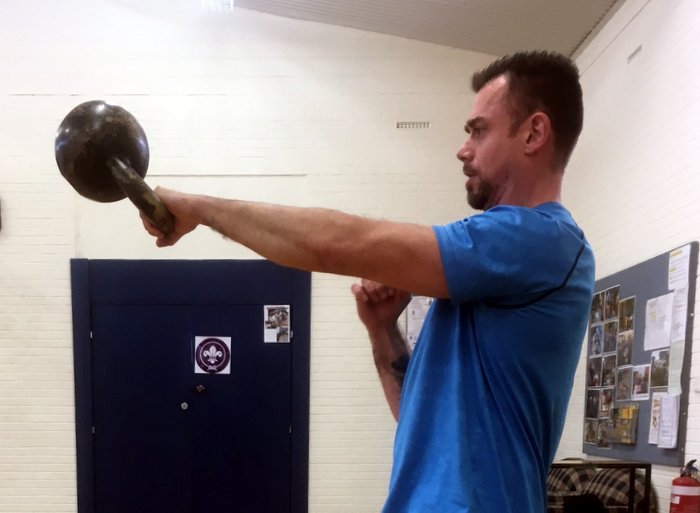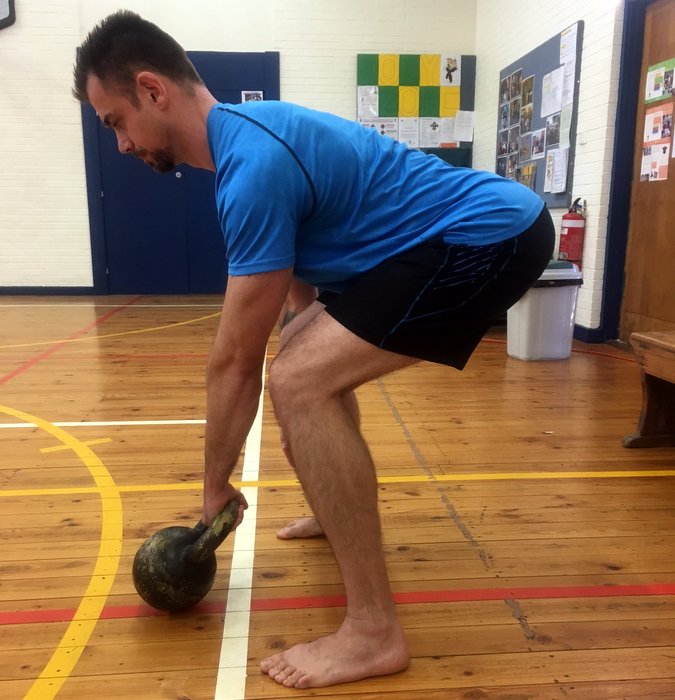
There’s no doubt that the swing is the center of the kettlebell universe. Mastering the swing should be one of the first goals of your kettlebell journey. It is simple—if you can swing well, you will probably clean and snatch your kettlebell properly too. Besides, the swing should look exactly like your clean and snatch, the hips do all the work and the arm guides the kettlebell to where you want it to go with some “steering strength”. While I consider the swing a basic, nailing it so it becomes a thing of power and grace can be difficult. “Basic” doesn’t mean “easy”.
My previous post, “Regress To Progress” steps out the progressions we use in the RKC to teach the swing. It explains how most kettlebell swing issues can be resolved by going back to master the progressions. Likewise, mastering regressions can really improve your kettlebell swing, no matter where you currently are in your practice.
In my opinion, great coaches give cues which can instantly and radically improve technique. I learned the two cues in this post from former Master RKC Geoff Neupert in my few years training with him. With these two cues, I feel like I can really transform a swing. I use them every time I teach at an RKC Workshop.
The timing of the swing movement is seldom discussed in detail, and yet it can play a very powerful part in making your swing a thing of grace and beauty—and powerful as hell!
One of the benefits of using kettlebells is working with the eccentric phase (the backswing) or downward phase of the kettlebell swing. The “overspeed eccentric” technique is a method to increase the intensity of the kettlebell swing in the RKC. This technique adds an active acceleration of the kettlebell on the backswing in addition to the ballistic concentric acceleration of the kettlebell during the forward swing phase. Instead of simply letting the kettlebell accelerate downward with gravity, a partner pushes the kettlebell down from the top of the swing. This assisted acceleration also increases the posterior chain’s eccentric muscle contraction speed.
During this eccentric muscle contraction, the muscles lengthen from the external load of the kettlebell while contracting under tension. Research shows that eccentric muscle contractions are capable of producing more force than either isometric or concentric muscle contractions. Maximum eccentric strength is estimated to be between 1.5 and 2.0 times that of maximum concentric strength. Put in other words, you get strong on the negative phase of exercises. This is why concentrating on the negative or eccentric phase will build the strength required for both phases of the exercise. For example, learning how to do a push up or pull up by focusing on the eccentric phase is the way to build the strength to do your first full push up or pull up.
“Overspeed eccentrics” result in an accumulation of kinetic energy from greater force production and elastic energy. Studies that have shown that training programs which utilize eccentric contractions at fast velocities remove neural inhibition. Normally, neural inhibition is a mechanism for injury protection as exemplified by the stretch reflex phenomenon. The rapid stretching of the posterior chain muscles in the backswing causes sensory muscle spindles—which are distributed throughout the fleshy part of skeletal muscle—to activate. To protect the muscle from being overstretched, the spinal cord is notified that the muscles are being lengthened. Next, the spinal cord reacts by contracting the muscle being stretched while inhibiting the contraction of the antagonist muscles. This process bypasses sending any messages to the brain and is known as the “stretch reflex”. Taking advantage of the muscle’s elasticity and the stretch reflex is also known as the “stretch-shorten cycle”. The faster the muscle is stretched eccentrically, the greater the force will be on the following concentric contraction. In other words, you will get a stronger and a more explosive swing.
To take advantage of overspeed eccentrics during the two-arm kettlebell swing, two things must be present: a fast backswing and a rapid switch from the eccentric muscle contraction of the backswing to a concentric contraction of the forward swing. This technique can be implemented with the kettlebell swing when a partner forcefully pushes the kettlebell down from the top of the swing at chest height as it we do it in the RKC.
Coincidentally, a common kettlebell swing technique error is to not get deep enough with the backswing. An insufficient backswing results in a lackluster swing without much force. The overspeed eccentric drill is one cure for this—along with other “A-HA drills” you will learn at an RKC workshop.

What if you don’t have a training partner?
Then, play chicken with the kettlebell! Yes, you read that correctly. Remember earlier in the article when I mentioned timing? We know that kettlebell swings are really ugly when your hips break and your bum goes backwards as soon as the kettlebell begins its downward or eccentric phase. That ugliness is usually just a timing issue.
Instead, try letting the kettlebell drop—or better still—pull the kettlebell down between your legs like a gridiron “hike pass”. Wait for the kettlebell to come down towards your hips, and for your elbows to connect to the rib cage, then right at the last second, forcefully “break” at the hips. You will hinge your hips down and back out of the way, getting a nice and deep backswing. The result will be similar to the overspeed eccentric drill. You’ll follow this with a powerful upward, concentric phase, giving you a much stronger and forceful swing. This is what I call “playing chicken with the kettlebell”. I probably don’t have to tell you what will happen if you wait too long… it will only happen once!
Breaking at the hips should not happen as soon as you reach the apex of your swing. Wait for the kettlebell to descend before hinging back. Be patient with your swing.
 Don’t Rush the Kettlebell Swing
Don’t Rush the Kettlebell Swing
Rushing the kettlebell swing is another one of the biggest technique errors. Lock off your hips for longer at the top
The second cue is probably something you probably think you’re already doing. You might think you’re using your glutes and hips effectively. Finishing your hips strongly at the top of the swing, just like a deadlift lockout, is paramount to using the glutes properly, protecting the back, and strongly completing the movement. But if you observe an average kettlebell swinger, you’ll see that their hip/glute activation or “lock-off” at the top of the swing only lasts for a split second before they turn it off again. Have someone video your kettlebell swing. For an exercise that is touted as a strong posterior activation exercise and glute developer, it’s surprising how many kettlebell swingers hit the top of the swing and don’t keep the hips/glutes locked for longer than a split second. In fact, many won’t finish with the hips at all on their swings. The remedy is to simply to keep your hips locked and glutes engaged for longer at the top of the swing.
This will also change the timing of your swing—you will find that your kettlebell will start to “float” for a second at the apex of the swing. This must happen in our swings if we want to snatch well since the “float” also requires relaxing the shoulders a little (while strongly gripping the kettlebell with straight arms) at the top. This is very different from many incorrect “swing” attempts that are really just a squat with a front raise.
Try the Two Simple Cues…
Play chicken with the kettlebell and work on your timing. Let the kettlebell drop or forcefully pull the it down. Only “break” and hinge at the hips at the last second. Be patient.
Lock your hips and engage your glutes for longer at the top of your swing. Try to “float” the kettlebell with your hips. Feel the change in timing and technique. It will radically power up your swing.
Let me know how you do in the comments section below.
****
Matthew Beecroft is a Senior RKC, PCC and CK-FMS certified instructor. He is also a GFM and Animal Flow instructor and Expert Level 2 instructor with Krav Maga Global and a Muay Thai coach who has trained amateur and professional Muay Thai champions. He can be contacted through his website www. realitysdc.com.au or Facebook page https://www.facebook.com/MeetLifeHeadOn/